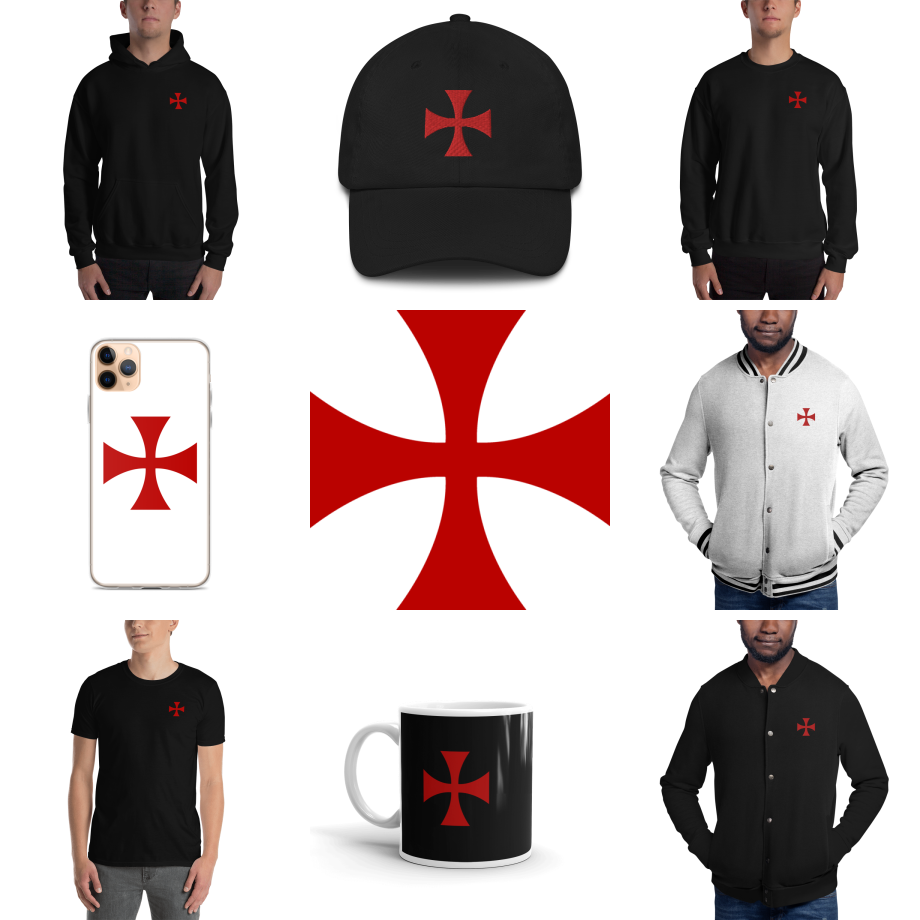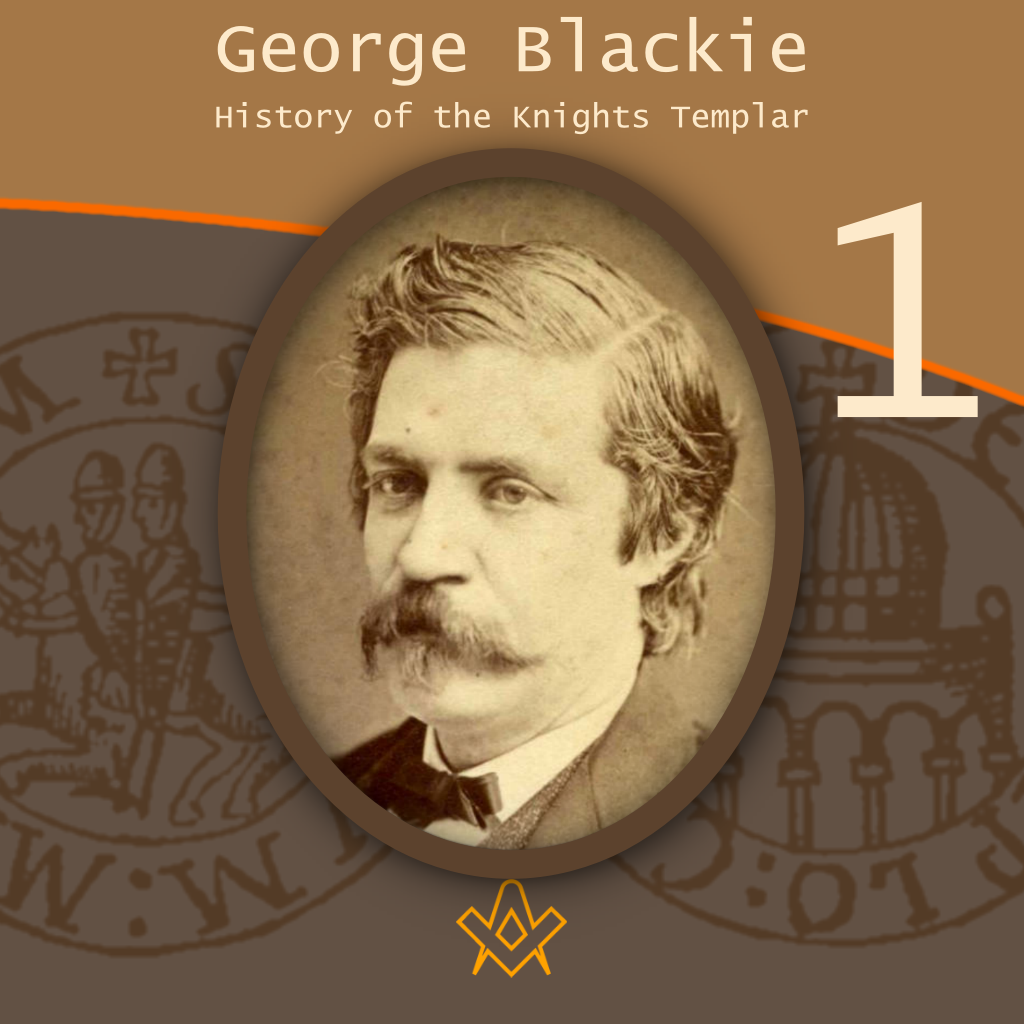On Ascension Day, May 6, 1869, Sir George S. Blackie, M.D., Knight Commander of the Great Priory of Scotland, Generalissimo of the Commandery, delivered an address to the Nashville Commandery of Knights Templar – entitled ‘The History of the Knights Templar and the Sublime Teachings of the Order’.
This oration has been transcribed, and the additional biography written below, by Kenneth Jack, and will be serialised over the coming months.
George Stodart Blackie and His Oration – ‘The History of the Knights Templar and the Sublime Teachings of the Order’
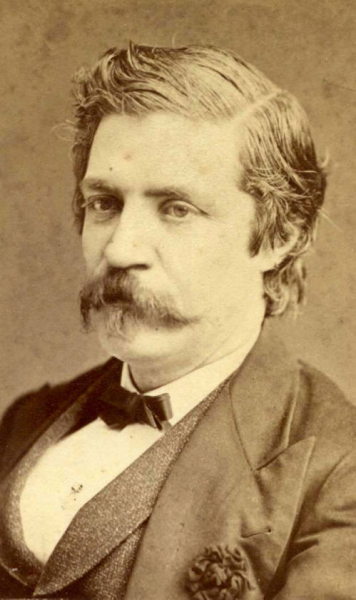
George Stoddart Blackie (1834-1881) 1860. Photographer R. Doole, Nashville, Tennessee
IMAGE CREDIT: Tennessee State Library and Archives
George Stodart Blackie was born on 10 April 1834, in Aberdeen, to Alexander Blackie, and Margaret Millar Paterson.
Through his maternal line, he was the great grandson of James Watt of steam engine fame.
He was educated in both Aberdeen, and Edinburgh, and studied medicine at the University of Edinburgh, and Bonn, Berlin, and Paris. He qualified in the degrees of A.M. and M.D. at Edinburgh.
He was initiated into Craft Freemasonry at Canongate Kilwinning Lodge, No. 2, Edinburgh, on 25 March 1857.
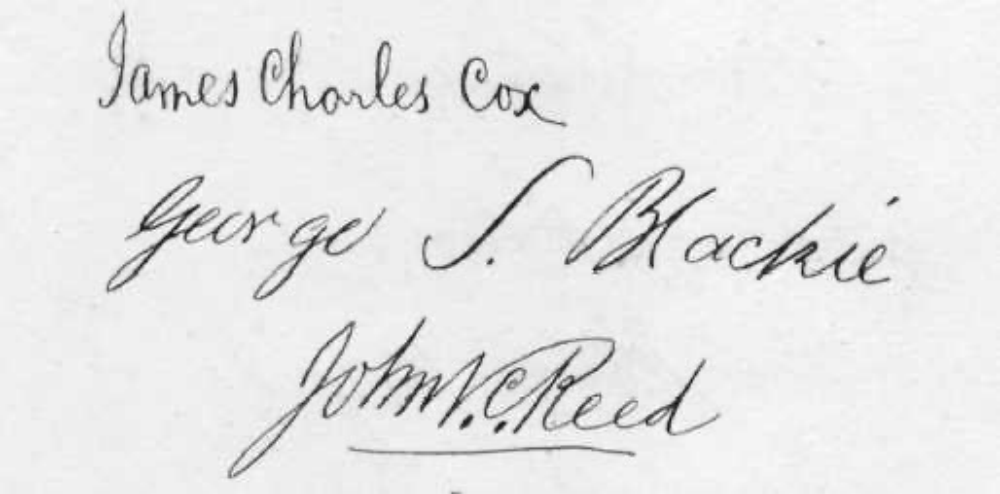
Signatures of G.S. Blackie and his fellow initiates. Image courtesy of Lodge Canongate Kilwinning 2, Edinburgh.
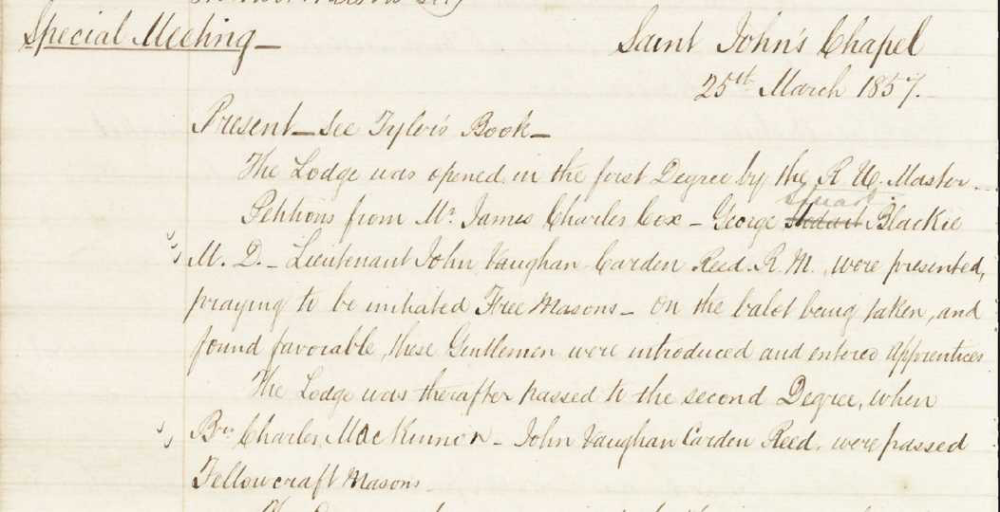
Minute of George Stodart Blackie’s initiation. Note that someone has erroneously scored out his proper middle name, and pencilled in that of his more famous half-brother, John Stuart Blackie. Image courtesy of Lodge Canongate Kilwinning 2, Edinburgh.
He plied his medical profession in Edinburgh for a short time, before emigrating to Nashville, Tennessee, USA. In 1858, he married Martha Elizabeth Cheatham.
In the United States, both his medical and Masonic careers carried on apace. He was Professor of botany, chemistry, and natural history, in the medical department at Nashville University, and later, held similar positions at Tennessee College of Pharmacy, and the Nashville Medical College.
He wrote extensively, both in research papers, and books, concerning his varied professional interests, and established a great reputation in those fields.
During the American Civil War, he served as a surgeon with the Confederate Army.
He was no less successful in his Masonic career, which he also took extremely seriously, and in which he was something of a pioneer.
He assumed the chair in most of the orders contained within what the Americans term the York Rite, including the Masonic Knights Templar; and in addition to his Masonic interests ‘across the pond’ he was made a Knight Commander of the Great Priory of Scotland, in his native land (note Americans refer to the Grand Priory of Scotland).
Blackie is often credited with the earliest attempts to introduce Masonic Rosicrucianism into North America, but scholars are sceptical about how much he achieved in this respect.
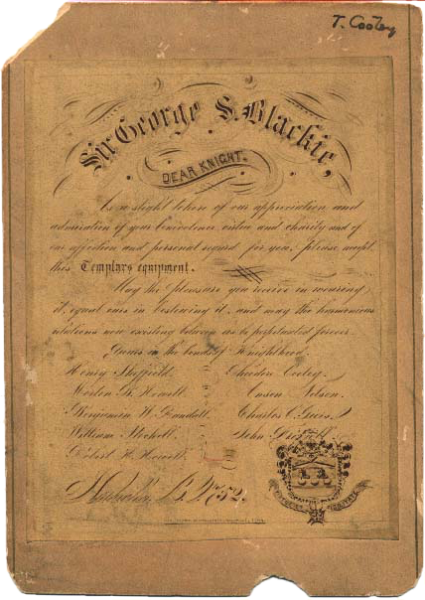
Masonic certificate awarding Templars equipment to George S. Blackie (1834-1881). C. 1870s
IMAGE CREDIT: Tennessee State Library and Archives Picture Collection
What is less in doubt is Blackie’s involvement in the introduction of the Royal Order of Scotland into North America.
In 1876, there were discussions in the United States of America, concerning the introduction of the Order there.
The legendary American Freemason, Albert Pike, then Sovereign Grand Commander of the Southern Jurisdiction, of the Ancient and Accepted Scottish Rite in the USA, corresponded with Brother John Whyte-Melville, Deputy Grand Master, and Governor of the Order, the Grand Lodge of which, is situated in Edinburgh, Scotland.
The two were on particularly good terms, and they agreed that the Order should be introduced into the USA and that Pike should head it.
However, Pike was not a member of the Order, and Edinburgh turned for assistance, to our subject George Stodart Blackie.
Blackie was one of only two members of the Order in the United States, and the only one who was a member of the Grand Lodge, having joined it in 1857.
He subsequently advanced and promoted Pike into the Order on 4 December 1876.
George Stodart Blackie was the half-brother of another famous Scotsman: John Stuart Blackie, considered to have been one of the most famous Scotsman of his day, John was a scholar, and ‘man of letters’, and Professor of Greek at the University of Edinburgh.
Like his younger sibling, he was a prolific author, of works on both Greek and Scottish history.
He was a biographer of the great Scots Bard, Robert Burns, and a noted poet in his own right.
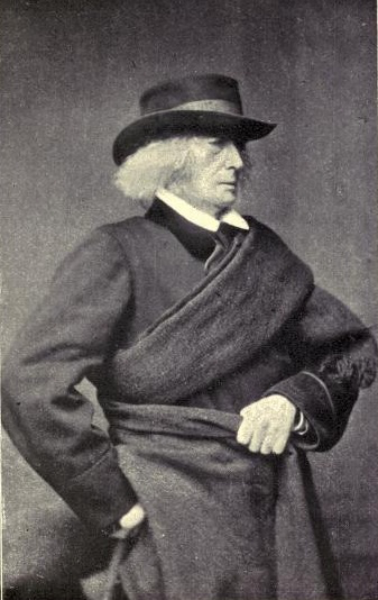
John Stuart Blackie (1809-1895) – By Howard Angus Kennedy – Professor Blackie, his Sayings and Doings: A Biographical Sketch with Illustrations
IMAGE LINKED: wikimedia Attribution 4.0 International (CC BY 4.0)
As a hopefully interesting sidebar to this biography, the present writer obtained a book some years ago, entitled: ‘The Persecution of the Knights Templar’ by Anthony Oneal Haye. Haye was a respected Edinburgh Freemason, and a contemporary of John Stuart Blackie.
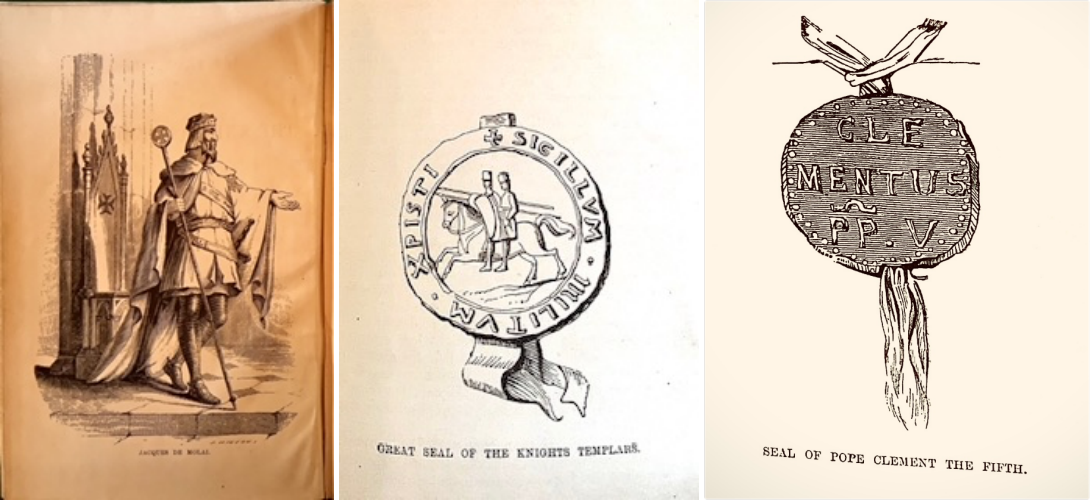
left: From ‘The Persecution of the Knights Templar’, by Anthony Oneal Haye (1865)
centre: From ‘The Persecution of the Knights Templar’, by Anthony Oneal Haye (1865)
right: From ‘The Persecution of the Knights Templar’, by Anthony Oneal Haye (1865)
IMAGE CREDIT: Author’s private Collection
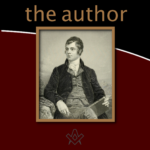
The Author – an ode
By Bro. Anthony Oneal Haye (1838-1877), Past Poet Laureate, Lodge Canongate Kilwinning No. 2, Edinburgh.
more….
On receiving the book, it was noted that there was a signature on one of the front-end papers, which was initially quite difficult to decipher. Beneath the signature was a dedication, reading ‘with the author’s compliments’.
The signature, and the dedication appeared contemporaneous and in the same ink, but the dedication was clearly written by Haye, judging from examples in his other works.
Following a degree of research and examination, it was found that the signature was that of John Stuart Blackie.
It appears very probable that Haye gifted John Blackie a copy of his book, and it also might suggest that like his brother George, John had an interest in the historical Knights Templar.
There is currently no evidence that John Stuart Blackie was a Freemason, but he is the author of a poem entitled ‘A Song of Freemasonry’, which is very positive, and extols the virtues and universality of the Craft.
George Stodart Blackie died in Nashville, Tennessee, on 19 June 1881, and a very fine headstone was erected to his ‘perpetual memory’, by local Freemasons.
The History of the Knights Templar and the Sublime Teachings of the Order:
An Address.
Delivered to The Nashville Commandery of Knights Templar, on Ascension Day, May 6, 1869.
By Sir George S. Blackie, M.D.,
Knight Commander of the Great Priory of Scotland, Generalissimo of the Commandery.
[IN compliance with the following request, contained in the resolutions of the Nashville Commandery, we have much pleasure in affording a large amount of our space to the Address of our Frater Blackie, to which we listened with the highest pleasure, and which, we are satisfied, will be read with profit and instruction by all the Brethren. – Ed.]
“At the stated conclave of Nashville Commandery, on Ascension Day, May 6th, A.D. 1868, A.O. 750, the following resolutions were unanimously adopted:
“Resolved, That the thanks of our Commandery are affectionately presented to Sir George S. Blackie, for his donation of a beautiful copy of ‘Our Great Light,’ and for his interesting address, to which we have listened this evening.
“Resolved, that he be solicited to furnish a copy of his address, to be preserved in the archives of the Commandery, with that of A. D. 1868, and future years, as memorials of our commemoration of this ‘Holy Anniversary.’
“Resolved, That the ‘MASONIC RECORD,’ be requested to publish these resolutions, and also the address, and that extra copies be printed for the Commandery.
“+ HENRY SHEFFIELD, E.C.
“Attest:
“ROBERT C. BRANSFORD, Rec.”
EMINENT COMMANDER, OFFICERS AND KNIGHTS, OF NASHVILLE COMMANDERY, No. 1:
At your request, I appear before you this evening to present a few facts and thoughts suggested by the remarkable history and sublime teachings of our magnanimous and most Christian Order.
I have been induced to comply with your flattering request solely from a desire to do my duty to the Commandery, and to add my little contribution to the enlightenment, and improvement of so august and worthy a body of my companions.
And I trust that I may be able to advance my opinions with the modesty which is becoming in a Soldier of the Cross, and that you will bear with my shortcomings in that spirit of Knightly forbearance and courtesy which has ever characterised the members of our Fraternity.
Without further preface, then, I commence to the remarks I have prepared for you, with a brief sketch of the History of our Order, a history not so familiar to many of us as it ought to be, and which will not, I believe, be out of place on this interesting anniversary.
The first inception of the Order may be dated from the 15th of July, 1099, A.D., when the First Crusade was ended, by the taking of Jerusalem, and the coronation of Godfrey de Bouillon as king of that city.
Nine of his followers bound themselves together, at this time, by a solemn vow, to defend the holy city, and its devout visitors, from Paynim outrage.
Of those nine, the names of but two – Hugo de Payens and Godfrey Adelaman – have come down to us through the mist of intervening ages.
The zeal of these men naturally attracted imitators, and many other Christian warriors, half soldiers, half monks or both, joined their league.
In 1118, Baldwin II., King of Jerusalem, granted them a residence contiguous to the Temple, from which circumstances their name is derived, and from which year we derive our date.
One hundred and ten years after, in 1228, they were recognised by the Council of Troyes, when a rule, or canonical order, was prescribed for them, and a white cloak with a red cross on the left shoulder, such as is still worn by the Order in Scotland, was appointed to be the uniform, or canonical dress.
After this, the Order spread rapidly over the countries of Europe. First, it was settled in France: but soon the Knights took root in Germany, Spain, Portugal, Sweden, Poland, Denmark, Sicily, Sardinia, Cyprus, Constantinople, and elsewhere.
It was established in England in 1185. Their real centre, however, eventually became the city of Paris, and the earliest trace of their presence there, is the record of a Chapter of about 130 members, who assembled, in 1147, in a house long known by the name La Vieux Temple, near the Place St. Gervais.
They left this place, however, and were settled in the Ville Neuve du Temple before the year 1182.
This building was on the corner of the Rue du Temple and the Rue de la Corderie. Here, for many years, the Order flourished in honour and renown.
Its main self-imposed duty; the defence of the Holy Land against the Paynim, was kept up with unsurpassed devotion and bravery.
In all the wars of the Crescent and the Cross, we find the Templar ever at the post of danger- at Jerusalem, at Cyprus, at Ptolemais- freely exposing himself in the deadly breach, or leading the forlorn hope.
“Clothed in simple attire, and covered with dust,” says the eloquent St. Bernard, in one of his spirit-stirring addresses in aid of the second Crusade;
“they present a visage embrowned by the heat of the sun, and a look haughty and severe.
At the approach of battle, they arm themselves with faith within, and with iron without; their weapons their only ornament, and these they use with courage in the greatest perils, fearing neither the numbers nor the strength of the barbarians; all their trust is in the GOD of armies; and in combatting for this cause, they seek a sure victory, or a glorious death. Oh! Happy mode of life, in which death is waited for without fear, desired with joy, and received with assurance of salvation!”
And this true military spirit animated them to the end of their history. No wealth nor power, no matter how great, ever caused them to forget that they were Soldiers of the Faith, and they never shrank from fatigue or exposure.
Their morals, despite all their enemies said, were good, though, I allow, not unexceptionable. But we must bear in mind that the manners of the age in which they flourished, despite its insane devotion to religious works, were anything but distinguished for purity.
The Crusades themselves naturally unsettled men, and broke in upon habits of peaceful industry, and adventurers thronged the cities of Europe, mischief- makers, rather than improvers of society.
A combination of devotion and licentiousness was a peculiar trait of the times, and the Templars I cannot believe, lived throughout them without becoming tainted.
Many, doubtless, forgot that they were monks, and behaved too much after the fashion of their comrades, the soldiers of the line.
And, too, when, in intervals of rest they returned to Paris, they were apt to relax the severity of monkish discipline by many new indulgences, for which their past services afforded some pretext or excuse.
Their wealth and power may have made pride and luxurious living common characteristics of their Order, and this was probably the full extent of the proof of degeneracy and corruption which their assailants could bring against them.
Certainly, no proof of the impiety and exaggerated profligacy with which they were charged, when their foes had predetermined to destroy them, was ever either brought, or even could have been brought forward.
In a work displaying much skill and research, published some fifty years ago, by M. Reynouard, of Paris, it is distinctly proved that the character of the Knights had remained unblemished by any of the calumnies brought against them, and from which their memory yet suffers in the estimation of many.
No trace of evil imputation is to be found in any document issued prior to the foregone determination to destroy them.
On the contrary, we find the most daring libellers of other churchmen commend the Knights of the Temple, and make their valour, piety, and munificent charity, the themes of highest praise, only a few years before the inauguration of the period of oppression and persecution.
While this does not establish their innocence, it establishes their unsullied reputation, and shows that the unfortunate impressions which have arisen in modern times, originated in the evidence fabricated to justify the condemnation of the Order, and have no other foundation.
The character of this evidence, fortunately, does not admit of much dispute.
Transcribed, and additional biography written by Frater Kenneth C. Jack, Strathearn Preceptory & Priory, No. 34, Crieff; The District Grand Priory of Tay Valley; The Great Priory of Scotland. © K.C. Jack
Article by: Kenneth C. Jack
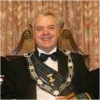
Kenneth C. Jack FPS is an enthusiastic Masonic researcher/writer from Highland Perthshire in Scotland.
He is Past Master of a Craft Lodge, Past First Principal of a Royal Arch Chapter, Past Most-Wise Sovereign of a Sovereign Chapter of Princes Rose Croix.
He has been extensively published in various Masonic periodicals throughout the world including: The Ashlar, The Square, The Scottish Rite Journal, Masonic Magazine, Philalethes Journal, and the annual transactions of various Masonic bodies.
Kenneth is a Fellow of the Philalethes Society, a highly prestigious Masonic research body based in the USA.
Recent Articles: Kenneth C. Jack
 Observations on the History of Masonic Research Archaeology is often associated with uncovering ancient tombs and fossilized remains, but it goes beyond that. In a Masonic context, archaeology can be used to study and analyze the material culture of Freemasonry, providing insight into its history and development. This article will explore the emergence and evolution of Masonic research, shedding light on the challenges faced by this ancient society in the modern world. |
 Anthony O'Neal Haye – Freemason, Poet, Author and Magus Discover the untold story of Anthony O’Neal Haye, a revered Scottish Freemason and Poet Laureate of Lodge Canongate Kilwinning No. 2 in Edinburgh. Beyond his Masonic achievements, Haye was a prolific author, delving deep into the history of the Knights Templar and leaving an indelible mark on Scottish Freemasonry. Dive into the life of a man who, despite his humble beginnings, rose to prominence in both Masonic and literary circles, leaving a legacy that continues to inspire. |
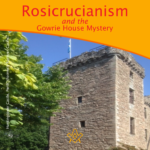 Rosicrucianism and the Gowrie House Mystery Unearth the mystifying intersections of Rosicrucianism and the infamous Gowrie House Mystery. Dive into speculative claims of sacred knowledge, royal theft, and a Masonic conspiracy, harking back to a fateful day in 1600. As we delve into this enthralling enigma, we challenge everything you thought you knew about this historical thriller. A paper by Kenneth Jack |
 Thomas Telford's Masonic Bridge of Dunkeld Of course, there is no such thing as a ‘Masonic Bridge’; but if any bridge is deserving of such an epithet, then the Bridge of Dunkeld is surely it. Designed by Scotsman Thomas Telford, one of the most famous Freemasons in history. |
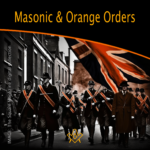 The masonic and orange orders: fraternal twins or public misperception? “Who’s the Mason in the black?” |
 Kenneth Jack's research reveals James Murray, 2nd Duke of Atholl – the 'lost Grand Master' |
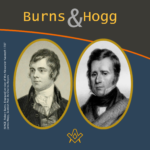 An Oration delivered to the Annual Burns and Hogg Festival, at Lodge Canongate Kilwinning, No. 2, Edinburgh, on 24 January 2018. By Bro. Kenneth C. Jack, FSAScot FPS, Past Master, Lodge St. Andrew, No. 814, Pitlochry. |
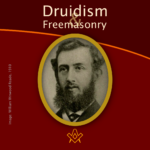 William Winwood Reade was a Scottish philosopher, historian, anthropologist, and explorer born in Crieff, Perthshire, Scotland. The following article by Kenneth Jack, provides some hints that William may have been a Freemason, but there is presently no definitive evidence he was. |
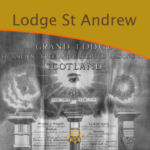 What's in a name? A brief history of the first Scottish Lodge in Australia - By Brother Kenneth C. Jack, Past Master, Lodge St. Andrew, No. 814, Pitlochry |
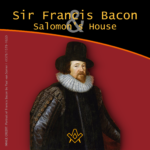 Sir Francis Bacon and Salomon’s House Does Sir Francis Bacon's book "The New Atlantis" indicate that he was a Rosicrucian, and most likely a Freemason too? Article by Kenneth Jack |
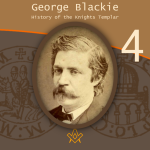 George Blackie – The History of the Knights Templar P.4 The final part in the serialisation of George Blackie's 'History of the Knights Templar and the Sublime Teachings of the Order' transcribed by Kenneth Jack. |
 George Blackie – The History of the Knights Templar P.3 Third part in the serialisation of George Blackie's 'History of the Knights Templar and the Sublime Teachings of the Order' transcribed by Kenneth Jack. |
 George Blackie – The History of the Knights Templar P.2 Second part in the serialisation of George Blackie's 'History of the Knights Templar and the Sublime Teachings of the Order' transcribed by Kenneth Jack. |
 George Blackie – The History of the Knights Templar P.1 First part in the serialisation of George Blackie's History of the Knights Templar and the Sublime Teachings of the Order – by Kenneth Jack |
 Little known as a Freemason, Bro Dr Robert ‘The Bulldog’ Irvine remains a Scottish rugby legend, and his feat of appearing in 10 consecutive international matches against England has only been surpassed once in 140 years by Sandy Carmichael. |
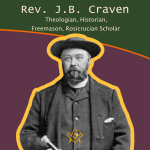 Rev. J.B. Craven: Theologian, Historian, Freemason, And Rosicrucian Scholar Archdeacon James Brown Craven is one of those unsung heroes of Scottish Freemasonry about whom very little has been previously written – here Kenneth Jack explores the life and works of this remarkable esoteric Christian. |
 Discover the powerful family of William Schaw, known as the 'Father of Freemasonry' |
 This month, Kenneth Jack invites us to look at the life of Sir William Peck; - astronomer, Freemason and inventor of the world's first electric car. A truly fascinating life story. |
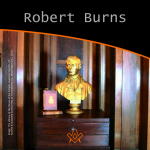 A Tribute to Scotland's Bard – The William Robertson Smith Collection With Burns' Night approaching, we pay tribute to Scotland's most famous Bard – The William Robertson Smith Collection |
 The Joy of Masonic Book Collecting Book purchasing and collecting is a great joy in its own right, but when a little extra something reveals itself on purchase; particularly with regards to older, rarer titles.. |
 Masons, Magus', and Monks of St Giles - who were the Birrell family of Scottish Freemasonry? |
 The 6th Duke of Atholl - Chieftain, Grand Master, and a Memorial to Remember In 1865, why did over 500 Scottish Freemasons climb a hill in Perthshire carrying working tools, corn, oil and wine? Author Kenneth Jack retraces their steps, and reveals all. |
 Charles Mackay: Freemason, Journalist, Writer Kenneth Jack looks at life of Bro Charles Mackay: Freemason, Journalist, Writer, Poet; and Author of ‘Tubal Cain’. |
 A Mother Lodge and a Connection Uncovered, a claim that Sir Robert Moray was the first speculative Freemason to be initiated on English soil. |
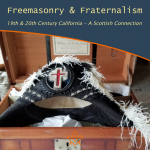 What is it that connects a very old, well-known Crieff family, with a former President of the United States of America? |
 The life of Bro. Cattanach, a theosophist occultist and Scottish Freemason |
 The Mysterious Walled Garden of Edzell Castle Explore the mysterious walled garden steeped in Freemasonry, Rosicrucianism, and Hermeticism. |
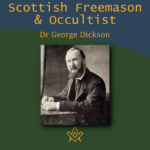 Dr. George Dickson: Scottish Freemason and Occultist Bro. Kenneth explores the life of Dr George Dickson a Scottish Freemason and Occultist |
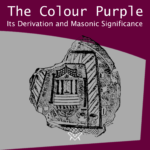 The Colour Purple - Its Derivation and Masonic Significance What is the colour purple with regards to Freemasonry? The colour is certainly significant within the Royal Arch series of degrees being emblematical of Union. |
 Bridging the Mainstream and the Fringe Edward MacBean bridging mainstream Freemasonry with the fringe esoteric branches of Freemasonry |
 Freemasonry in the Works of John Steinbeck We examine Freemasonry in the Works of John Steinbeck |
 Renegade Scottish Freemason - John Crombie Who was John Crombie and why was he a 'renegade'? |
 Scottish Witchcraft And The Third Degree How is Witchcraft connected to the Scottish Third Degree |
masonic knowledge
to be a better citizen of the world
share the square with two brothers

click image to open email app on mobile device
